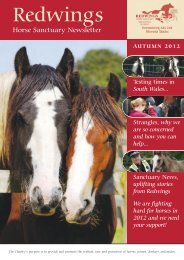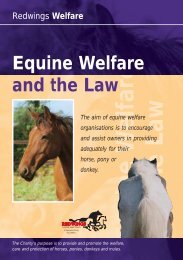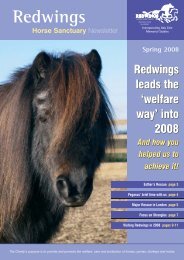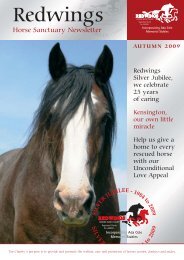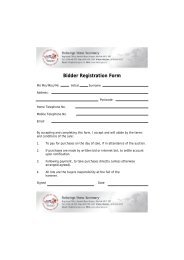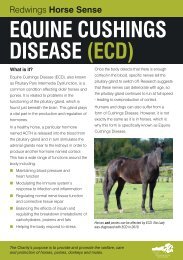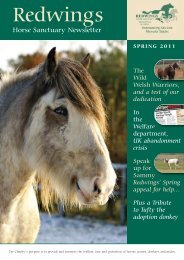STRANGLES - Redwings
STRANGLES - Redwings
STRANGLES - Redwings
Create successful ePaper yourself
Turn your PDF publications into a flip-book with our unique Google optimized e-Paper software.
Part Five<br />
IF IT HAPPENS…<br />
A new arrival to <strong>Redwings</strong><br />
has a routine endoscopy<br />
You must quarantine any horse displaying symptoms<br />
immediately. You must restrict the movement of any<br />
horses that came into contact with that particular horse.<br />
1) Physically move the horses on the yard into three<br />
quarantine groups. Make sure each group is<br />
easily identifiable:<br />
Group One: Infected horses and those displaying<br />
symptoms<br />
Group Two: Those that have been in direct or close<br />
contact with the infected horses<br />
Group Three: Those that have not been exposed to<br />
either of the above groups<br />
Strangles has a 7 to 14 day incubation period. This<br />
means that groups two and three will show Strangles<br />
symptoms within two weeks if they have come<br />
into contact with the bacteria. However, we would<br />
recommend that you keep groups two and three apart<br />
until quarantine has been lifted and you have been<br />
given the ‘all clear’ by a vet.<br />
2) Notify vets straight away. Tell them you suspect<br />
Strangles and that you have set up quarantine areas<br />
to ensure they arrive equipped with the required<br />
drugs and equipment.<br />
3) Ensure your quarantine areas are well stocked with<br />
all the necessary equipment, as listed on the<br />
‘Quarantine set-up checklist’.<br />
4) Notify all staff and livery yard users of what is<br />
happening, and make sure everybody has copies of the<br />
‘Quarantine protocol’. Make sure you have a procedure<br />
in place for the disposal of muck, leftover forage and<br />
used bedding from the quarantine area. It is important<br />
that everybody complies with the quarantine protocol,<br />
otherwise your efforts will be fruitless.<br />
5) Stop all movement of horses on or off the yard. Make<br />
sure ‘Quarantine area notices’ are clearly displayed<br />
and that the boundaries are clear.<br />
6) Regularly communicate with those on the yard so<br />
everybody is up to date with the situation. Advise any<br />
neighbours who look after horses.<br />
7) Disinfect the area where the horse showing clinical<br />
signs was found.<br />
Care and management of Group One<br />
Your vet will advise you on antibiotics and pain relief.<br />
They will diagnose Strangles through one of three<br />
methods:<br />
1) Swabbing is where three consecutive swabs are taken<br />
at weekly intervals and sent for testing in a lab.<br />
2) Testing via endoscopy is the most reliable method. A<br />
sample is taken directly from the guttural pouch in the<br />
throat and sent for testing. This can also determine<br />
whether a horse is a carrier or not.<br />
3) Blood tests identify if a horse has antibodies to the<br />
Strangles bacteria in their bloodstream. Antibodies<br />
are produced approximately two weeks following<br />
exposure to the bacteria and last up to six months.<br />
Horses that have been exposed to the bacteria in the<br />
last six months will test positive.<br />
Keep the horse in a stable if possible, as it will be feeling<br />
unwell and will need to rest and stay warm.<br />
Make all feeds nice and soft in texture. The horse may<br />
struggle to reach the floor as it will have a sore throat.<br />
You can use a stable manger or raise its feed bowl from<br />
the floor using upturned tyres or a plastic bin. However,<br />
if the horse has ruptured abscesses, feeding from the<br />
floor can help them drain.<br />
Bathe ruptured abscesses with cotton wool and warm<br />
water. Use a warm compress on unruptured abscesses.<br />
Do not attempt to squeeze abscesses or put anything<br />
in them.<br />
All equine professionals that visit your yard – such<br />
as farriers – should already know how to work within<br />
quarantine. It is important you notify visitors that<br />
there is a quarantine area on site. If you can, ask for an<br />
appointment towards the end of the day to prevent the<br />
farrier needing to shower and change clothes before<br />
touching other horses. You can spray their equipment<br />
with disinfectant before it is taken off site.<br />
Care and management of Group Two<br />
Keep human movement between areas to a minimum.<br />
Only turn out in the designated area for the horses in<br />
this category. Use separate equipment for this group.<br />
Keep a close eye on the horse’s demeanour and appetite.<br />
Record their temperature at the beginning and end<br />
of each day. Ask your vet how to do this. If you see a<br />
sudden rise, immediately move the horse to group one.<br />
Discuss with your vet if there is any benefit in putting<br />
these horses on antibiotics. This will depend on<br />
circumstances and the level of exposure. Your vet will<br />
also advise on using the vaccine Equilis Strep E.<br />
Care and management of Group Three<br />
Make sure these horses do not come into contact with<br />
any equipment used in the quarantine area, or that used<br />
for the horses that have been in close contact.<br />
Make sure carers and owners of the ‘clear’ horses are<br />
respectful and supportive of quarantine practices.<br />
Keep a close eye on these horses for any clinical signs.<br />
If you see any clinical signs, move them to group one.<br />
Do not mix these groups until you have<br />
been given the ‘all clear’ by a vet.<br />
Any horse that has had Strangles must have<br />
a negative test result before it is removed from<br />
quarantine. It could continue to shed bacteria for<br />
several weeks after clinical signs have stopped –<br />
or it could be a ‘carrier’.<br />
This may take months, so the quicker you act at the<br />
beginning and the more attention to detail given to<br />
ensure a high standard of quarantine – the sooner<br />
things will get back to normal.<br />
Record temperatures regularly<br />
<strong>Redwings</strong> guide to Strangles. Page 12<br />
<strong>Redwings</strong> guide to Strangles. Page 13




